|
|
|
Sort Order |
|
|
|
Items / Page
|
|
|
|
|
|
|
| Srl | Item |
| 1 |
ID:
147832
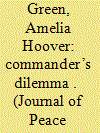

|
|
|
|
|
| Summary/Abstract |
This article proposes a framework for understanding variation in armed groups’ abilities to control wartime violence, including violence against civilians. I argue that patterns (both levels and forms) of violence are shaped by armed group leaders’ attempts to meet two conflicting imperatives. To succeed, commanders must build a fighting force capable of swift, unhesitating violence; they must also maintain some control over the level, form(s), and targeting of violence. I refer to this situation as the Commander’s Dilemma. Drawing on literatures from psychology and sociology, I argue that effective behavioral control cannot be achieved via extrinsic incentives (i.e. pecuniary or non-pecuniary rewards and punishments) alone. Rather, effective control of combatant violence depends upon armed group institutions intended to align combatants’ preferences with those of commanders. I therefore focus analytically on political education, the armed group institution most likely to operate in this way. In particular, I hypothesize that armed groups with strong and consistent institutions for political education should display, on average, narrower repertoires of violence than those without. This argument finds preliminary support in a cross-national analysis of reported rape by rebel forces, as well as a qualitative investigation of armed groups during civil war in El Salvador. More broadly, this approach suggests that the creation of restraint is at least as important to our understandings of wartime violence as the production of violence.
|
|
|
|
|
|
|
|
|
|
|
|
|
|
|
|
| 2 |
ID:
147833
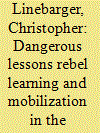

|
|
|
|
|
| Summary/Abstract |
Contemporary research on the international diffusion of civil conflict privileges physical, proximity-based variables like conflict spillover and refugee flows. I argue that the international diffusion of civil strife can occur through a learning mechanism, and that this phenomenon may occur on a worldwide basis. Individuals most likely to rebel, or proto-rebels, may learn about the utility of rebellion before mobilizing and violently challenging the state. Such international learning therefore occurs during the pre-conflict process. International sources by which proto-rebels learn include active, ongoing civil wars, as well as revolutionary governments that have been founded by rebels victorious in past wars. Revolutionary governments radically shock the international system, teaching proto-rebels about the possible benefits to be gained from violently challenging the state. In order to test these assertions, I undertake empirical analyses using militant organization data that capture the year in which rebel movements first emerge, during the period 1968–2001. I then explore the spatial and temporal relationships between rebel movement emergence, civil conflict, and revolutionary regimes, using the country-year as my unit of analysis. I further examine how these relationships are attenuated by cultural and regime-type similarity. I find, in line with the literature, that active civil conflicts generally inspire rebel mobilization only in directly neighboring states, while revolutionary regimes established after rebel victories are associated with mobilization on a global basis. I conclude that proto-rebels learn and take inspiration from some global sources of information, and that significant analytical utility is to be gained by focusing on revolutionary regimes established as a result of rebel victories, as well as mobilization in the pre-conflict process.
|
|
|
|
|
|
|
|
|
|
|
|
|
|
|
|
| 3 |
ID:
147834
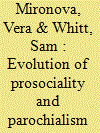

|
|
|
|
|
| Summary/Abstract |
To what extent can prosocial norms (re-)emerge among rival groups following intense intergroup conflict? One school of thought posits that violence can strengthen intragroup bonding norms, entrenching parochialism and sustaining in-group biases. However, recent studies suggest that intergroup bridging norms can also improve once conflict ends. Our research offers insights into how prosocial bridging vs. parochial bonding norms evolve after violence. To measure dynamics of social norms, we employ surveys and dictator game experiments with ethnic treatments which we administered in Bosnia in 2003 and replicated in 2013 using well-balanced samples of ethnic Bosniaks, Croats, and Serbs in a difference-in-difference research design. We find that prosocial bridging norms improve over time. However, we also observe persistent parochial biases in terms of how in-groups are perceived and treated relative to out-groups. Regression analysis shows that intergroup bridging norms are more salient among individuals who reside in ethnically intermixed, institutionally integrated regions of Bosnia, including those who experienced traumatic forms of wartime victimization. Covariate matching on internal displacement and victimization reduces concerns that our results are driven by selection effects. Our findings lend support to the view that integration and intergroup contact among former rivals increases prosociality while partition and social segregation encourage parochialism.
|
|
|
|
|
|
|
|
|
|
|
|
|
|
|
|
| 4 |
ID:
147838
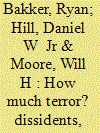

|
|
|
|
|
| Summary/Abstract |
Our knowledge of the set of concepts that influence the number of terror attacks experienced by different countries is rudimentary. Existing work on the incidence of terror focuses upon the structural characteristics of polities, economies, and societies, and fails to place competition between dissidents and states center stage. It also tends to treat terror as isolated from other tactics that dissident groups might use to pressure the state. This study addresses these shortcomings by placing government and dissident group behavior at the center of the analysis. Drawing on arguments from the larger literature on dissent and repression, we argue that government behavior and dissident behavior are likely to be more important determinants of terror attacks than structural factors. We scour the literature for existing arguments to round out our model specification, and evaluate hypotheses using Bayesian statistical techniques and a broad scope of relevant data. For many of our independent variables we construct indices using measurement models that are able to account for measurement error and missing data, resulting in a more comprehensive set of data than previous studies. The results demonstrate that measures of government and dissident behavior have more explanatory power than measures of the concepts that populate existing research.
|
|
|
|
|
|
|
|
|
|
|
|
|
|
|
|
| 5 |
ID:
147837
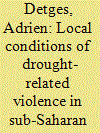

|
|
|
|
|
| Summary/Abstract |
Despite growing concerns about the possible security implications of extreme precipitation shortfalls in vulnerable and politically fragile regions, the particular conditions that make armed violence more or less likely in times of drought remain poorly understood. Using a spatially disaggregated research design and focusing on sub-Saharan Africa, the present analysis assesses how far violent and nonviolent outcomes in the wake of drought can be accounted for by regional differences in the provision of key infrastructures that help coping with drought and preventing violence. The results indicate that civil conflict events in connection with drought are more likely in administrative areas with poorly developed road infrastructures. Drought-related communal violence, on the other hand, is more likely in regions where an important part of the population lacks access to an improved water source. Thus, while the provision of key infrastructures seems to moderate local conflict risks in connection with drought, there are nevertheless important distinctions with regard to different types of infrastructures and forms of armed violence. However, the importance of precipitation shortfalls as a conflict-facilitating factor in sub-Saharan Africa should not be overstated, as the overall contribution of drought measures to predicting violent events is modest in all calculated models.
|
|
|
|
|
|
|
|
|
|
|
|
|
|
|
|
| 6 |
ID:
147839
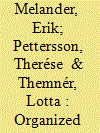

|
|
|
|
|
| Summary/Abstract |
The alarming upward trend since 2012 in the number of fatalities incurred by organized violence did not continue in 2015. Indeed, 2014 saw more than 130,000 people killed in organized violence while in 2015 this figure was close to 118,000. This is still an unusually high number, the third-worst year in the post-Cold War period. The number of conflicts continued to increase from 41 in 2014 to 50 in 2015. This increase was by and large driven by the expansion of the Islamic State. Most of the fatalities, over 97,000, incurred in state-based conflicts. Non-state conflicts also increased, from 61 in 2014 to 70 in 2015, the highest number recorded in the 1989–2015 period. No non-state conflict passed the threshold of 1,000 battle-related deaths, but 11 state-based conflicts did – a decrease by one from 2014. Seven of the ten most violent state-based conflicts in 2014 became less violent. Twenty-six actors were registered in one-sided violence just as in 2014, while the number of fatalities decreased from over 13,500 to 9,500.
|
|
|
|
|
|
|
|
|
|
|
|
|
|
|
|
| 7 |
ID:
147835
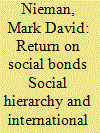

|
|
|
|
|
| Summary/Abstract |
This article takes a game-theoretic and latent variable approach to modeling the effect of international social hierarchies on conflict among states. I start with the premise that international states are social actors and are nested within informal social networks of friendly and conflictual relationships. Rather than lateral relationships among equals, networks among states tend to have a vertical or hierarchical structure. Although international hierarchical relationships may arise as a result of material power asymmetries, this article focuses on non-material asymmetries that stem from political legitimacy or policy innovation – a subject that has received less attention in scholarly research. I argue that, within these hierarchies, states adopt one of two roles – a dominant or a subordinate. Each resulting (dyadic) dominant–subordinate relationship is a social contract, in which the subordinate concedes some autonomy in exchange for the dominant’s protection. This social hierarchy affects the relationships among subordinates, as well as between a dominant and subordinates. The model predicts that a state’s degree of subordination reduces its probability of conflict initiation against other subordinates. Moreover, the decision to initiate conflict is influenced by the expectation that the dominant will intervene, which itself is affected by the target’s relative level of subordination to the dominant vis-à-vis the challenger. These predictions are supported by empirical analyses of the US hierarchy (1950–2000).
|
|
|
|
|
|
|
|
|
|
|
|
|
|
|
|
| 8 |
ID:
147836


|
|
|
|
|
| Summary/Abstract |
Does class inequality increase the risk of civil war? I posit that inequality between social classes affects civil wars through two pathways: (1) it heightens the risk of political violence by fueling distributive conflicts; and (2) it reduces structural coup-proofing, which, in turn, increases the capacity of the military to fight insurgents. Combining these effects implies that the net effect of class inequality on civil war is ambiguous. Although class inequality increases the propensity for violence, in unequal countries political violence rarely takes the form of wars because such countries have strong militaries. Class inequality, however, breeds other forms of political violence. In particular, it increases the likelihood of military coups. The two effects of class inequality reinforce each other in the case of coups: inequality simultaneously stirs distributional conflicts and increases the capacity of the military to mount coups by reducing coup-proofing. Using data on 128 developing countries between 1960 and 2008, I find that while class inequality fosters coups, it has no discernible effect on civil wars. I also provide evidence consistent with my causal mechanisms: (1) inequality creates greater threat to the rulers by fueling political instability; (2) inequality reduces structural coup-proofing; and (3) structural coup-proofing increases the likelihood of civil war.
|
|
|
|
|
|
|
|
|
|
|
|
|
|
|
|
|
|
|
|
|